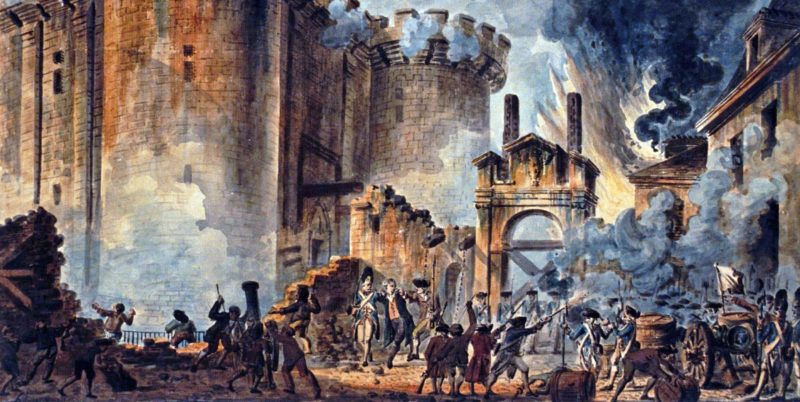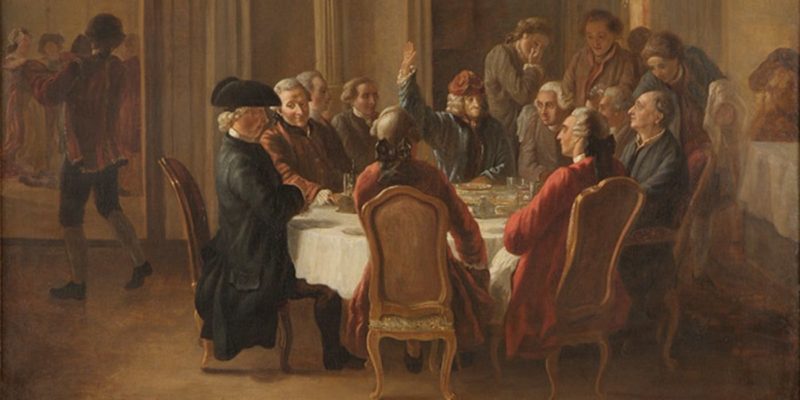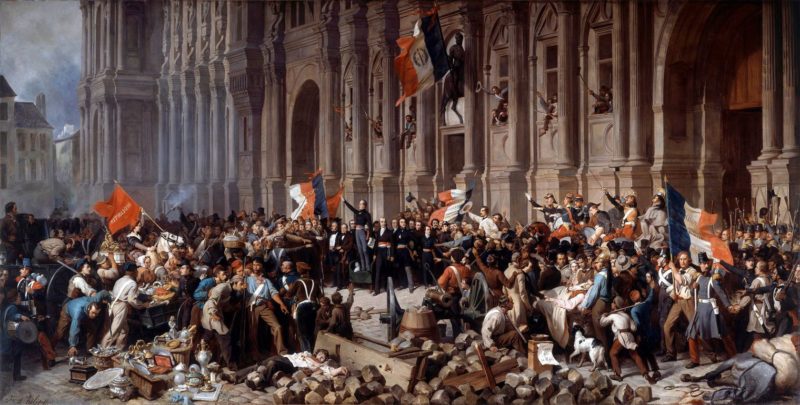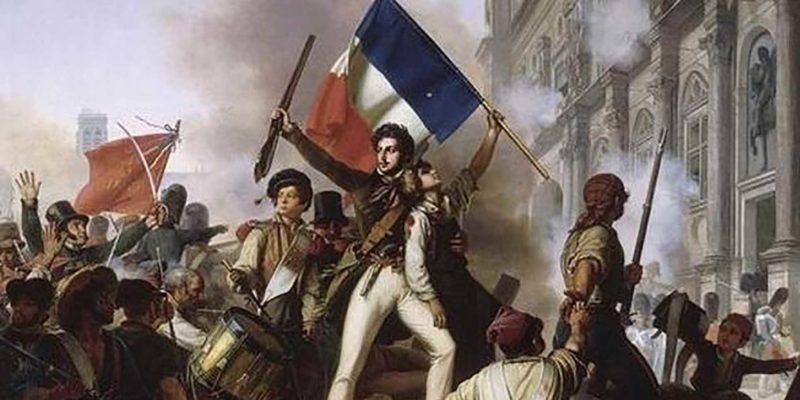We explain what the French Revolution was, its causes and consequences. Its social organization and revolutionary groups.
What was the French Revolution?
The French Revolution of 1789 was a violent conflict between two socio-political systems, the absolutist monarchy and the bourgeois class that took power . The ideological and political impact that the revolution unleashed influenced the rest of the countries of Europe and it was considered the beginning of a new era: the Contemporary Age .
The absolute monarchy was a system in which all powers were controlled by one king, and it had prevailed in many of the European countries for centuries. After the French Revolution the powers were divided: the legislative in charge of a parliament, the executive in charge of the highest representative and the judicial in charge of a court. They were the foundations of the democratic system that exists today, in many countries of the world.
The French Revolution was one of the most violent armed outbreaks in history . It broke with the traditional monarchical system and allowed a new society to emerge whose ideals were based on reason, equality before the law and freedom . However, those ideals could not be implemented in practice.
Causes of the French Revolution

The causes that detonated the French Revolution were multiple, among the main ones, the following stand out:
- Change in social structure. The feudalism , implemented since the Middle Ages , was a system in which the landowner paid part of that fief to vassals in exchange for slave labor. With the growth of a new elite, made up of commoners, merchants, artisans, and professionals, feudalism gradually weakened. The so-called bourgeois aspired to access political power.
- Population increase. Society had achieved a better quality of life, even for the working class, who had access to education . The general population had a longer life expectancy . However, poor harvests hurt that outlook.
The reduction in the death rate and the improvement in the quality of life of the commoners generated an increase in the population that doubled in less than a century. In 1789 France was the most populous country in Europe, with 26 million inhabitants, which generated a growing demand for food, difficult to satisfy.
- It was of enlightened thinking. A cultural and intellectual movement called Enlightenment predominated , considered as "the age of lights" and which alluded to the illumination of ideas through reason to explain the world. This knowledge was captured and published in the encyclopedia. The Enlightenment was opposed to the theocentrism of the monarchy , in which a single God was the center of everything and who dominated all aspects of life. The new intellectuals, such as Montesquieu, Voltaire or Rousseau, argued that knowledge could combat ignorance, superstition and tyranny.
France was under the rule of an absolute monarchy reigned by Louis XVI and his wife Marie Antoinette, a government that did not adapt to the crisis situation. The French State had a precarious economy as a result of bad harvests and great military spending, while the nobility continued to squander in luxuries, indebting the State even more .
The economic depression and the social discontent of a hungry people, added to the new enlightened mentality, ignited the engine of a violent social confrontation. The fact that determined the outbreak was the suspicion that Louis XVI wanted to dissolve the National Assembly, the one in charge of writing a Constitution.
On July 14, 1789, the people of Paris took to the streets to support the National Assembly and took by force the Bastille fortress, a prison considered a symbol of the absolutist monarchy. The revolutionary Jean-Paul Marat founded a renowned newspaper and became the spokesman for a part of the people.
Organization of French society

French society was made up of three main groups called states:
- First state. It was represented by the Church , which did not pay taxes and received from the peasants a tithe or contribution consisting of 10% of their crops. Education could only be controlled and promulgated by the ecclesiastical institution.
- Second state. He was represented by the nobility, the owners of the lands. They also did not pay taxes and the peasants had to pay them a tribute, in addition to respecting certain conditions, such as that they could only sell their crops to the nobles.
- Third state. It was represented by the bourgeoisie, merchants, bankers, medical professionals, among others, and by free peasants, small owners, tenants, and day laborers. They paid taxes to the Church and the nobility, they lacked power and political decision, they did the worst jobs and they had no rights.
Consequences of the revolution
 Among the main consequences of the revolution are:
Among the main consequences of the revolution are:
- The declaration of the rights of man and of the citizen , on August 26, 1789.
- The writing of a Constitution to reorganize the powers of the State.
- The end of feudalism and serfdom.
- The law of civil constitution of the clergy and the appropriation of the property of the Church.
- Freedom of the press and dissemination of knowledge .
- The new parliament of 1792, called the Convention, which abolished the monarchy and proclaimed the Republic .
- The execution of Louis XVI in 1793, condemned by the Convention.
Revolutionary groups
 The revolutionary groups in France at that time were:
The revolutionary groups in France at that time were:
- Jacobins. They were represented by professionals and small owners who aspired to the most radical changes, such as ending the monarchy and founding a democratic republic, with the right to vote from all social classes . The main exponent was Maximilien Robespierre.
- Girondins. They were represented by the bourgeois entrepreneurs and large merchants , who aspired to more moderate changes, such as limiting real power (not abolishing it completely), with the right to vote of the upper and bourgeois classes, excluding the poor. They came from the region called Gironde, in the south of France. The main exponent was Georges-Jacques Danton.
Both groups clashed, in part, because the bloodthirsty Jacobin Jean-Paul Marat published in his newspaper supposed traitors of the republic (those Girondins who aspired to moderate and non-radical changes like the Jacobins). Marat was assassinated, but he ended up becoming a legend of the radical Jacobins.
Between 1793 and 1794 the Jacobins unleashed the reign of terror through a tyranny in which 40,000 people were assassinated at the guillotine after being accused of practicing counter-revolutionary activities, for being priests or members of the nobility.
A civil war broke out between revolutionaries and anti-revolutionaries called the Vendée War, which unleashed even greater terror. Danton promoted the end of the terror and was executed, reason why many considered that, to end this tyranny, Robespierre had to be annihilated. That's how it went. The terror ceased, but the revolution continued.
The above content published at Collaborative Research Group is for informational and educational purposes only and has been developed by referring reliable sources and recommendations from experts. We do not have any contact with official entities nor do we intend to replace the information that they emit.
Luke is passionate about fostering student involvement and connection. He studied psychology for his major and likes learning about the past. Luke aims to specialize in artificial intelligence and cybersecurity. .
Leave a reply
Your email address will not be published. Required fields are marked *Recent post

Sport: What Is It, Types, Risks, Features, Characteristics and Examples

Dogs: Emergence, Features, Characteristics, Feeding and Breeds

Story: Definition, Elements, Structure, Features and Characteristics

